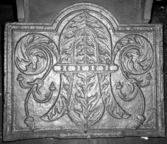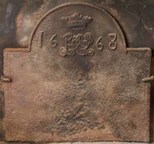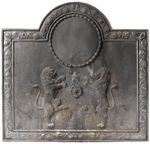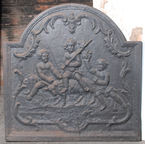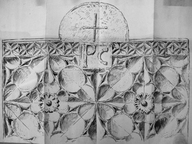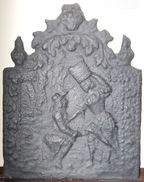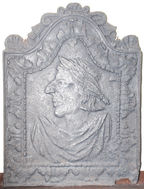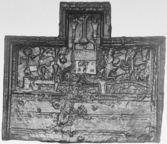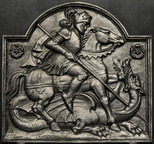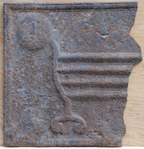-
352
Description: Arched rectangular shape; cyma curve and astragal edging; fleur de lys formed from acanthus leaves within a circlet, between swirled, budded fronds, all in bas-relief.
Notes: An uncommon English fireback with a purely floral design.
Copies of this fireback are known.
- Decoration tags:
- rectangular with round arch (shape)
- cyma curve and astragal (edging)
- whole carved pattern
- heraldic
- plants
Manufactured: in the mid-17th century in England.
Current location: Christchurch Mansion, Ipswich, Suffolk, England.
(part of the Colchester & Ipswich Museums Service museum group)
- Attached to series:
- Miscellaneous pattern firebacks
-
1225
Description: Arched rectangular shape; twisted rope edging (top and sides); in arch, marquess's coronet above a monogram with date split either side.
Notes: The elaborate monogram has not been deciphered, but the fireback does not appear to be related to the Talbot family who owned Lacock throughout the 17th century.
Inscription: 16 [undeciphered monogram] 68
- Decoration tags:
- rectangular with round arch (shape)
- rope (edging)
- whole carved pattern
- individual numbers
- heraldic
- monogram
- text
Manufactured: in 1668 in England.
Current location: Lackock Abbey, Lacock, Wiltshire, England.
Museum number: 996713 (part of the National Trust museum group)
- Attached to series:
- Miscellaneous pattern firebacks
-
365
Description: Arched rectangular shape; astragal edging with parallel astragal enclosing a border of undulating convolvulus vine, leaves and flowers; bead and disc circle in arch, above a pair of lions rampant facing each other, between which are a five-pointed star above a rose.
Notes: A fireback in a retro-Regency style. Sotheby's auction, 27 Oct 2010, lot 209 (£2,500)
Copies of this fireback are known.
- Decoration tags:
- rectangular with round arch (shape)
- astragal (edging)
- whole carved pattern
- heraldic
- animals
Manufactured: in the late-19th to early-20th century in England.
Current location: in private hands, Lambourn, Berkshire, England.
- Attached to series:
- Miscellaneous pattern firebacks
-
367
Description: Arched rectangular shape; fillet and cavetto moulded edging; pictorial scene of three children, the centre one holding a stick strung with a bunch of grapes over his shoulder, and sitting on a goat.
Notes: A mythological scene of the young Bacchus.
- Decoration tags:
- rectangular with round arch (shape)
- fillet and cavetto (edging)
- whole carved pattern
- pictorial
- mythological
- humans
Manufactured: in the 18th century in France.
Current location: Newarke Houses, Leicester, Leicestershire, England.
Museum number: H.358.1953.0.0 (part of the Leicester City Museums museum group)
Citation: Carpentier, H., 1912, Plaques de Cheminées (Paris, published by the author).
- Attached to series:
- Miscellaneous pattern firebacks
-
1083
Description: Arched rectangular shape; fillet edging (top and sides); twisted rope cross in centre of arch; fillet-edged square below arch containing initials of uneven size; along the top, a line of five quatrefoils on each side of the initials; below, two symmetrically carved roundels and associated spandrels, each with a central flower.
Notes: The quatrefoils and roundels are likely to have been part of a redundant, probably medieval, furniture panel, perhaps from a chest. The life-size rubbing, reinforced with ink, is by W. R. Lethaby. The fireback was formerly property of the artist John Callcott Horsley RA (1817-1903) at Wilsley Green, Cranbrook, Kent.
Inscription: PC
- Decoration tags:
- rectangular with round arch (shape)
- fillet (edging)
- carved pattern panels
- apotropaic
- text
- objects
Manufactured: in the mid- to late-16th century possibly in the Weald area of England.
Current location: Victoria & Albert Museum, Cromwell Road, Kensington & Chelsea, London, England.
Museum number: 3267-1932 (part of the Victoria & Albert Museum museum group)
Citation: Lethaby, W. R., 1 Oct 1926, 'English Cast Iron - I', The Builder, 131, no. 4365, pp. 537-8.
- Attached to series:
- Miscellaneous pattern firebacks
-
417
Description: Rectangular central panel with top arch, bead edging; pictorial scene of a a kneeling man in a wide-brimmed hat reaching up the skirt of a milk maid, who in fending him off, leans forward, tipping the milk from the bucket on her head over the man; acanthus leaves over the top arch; side border with bead edging extending over shoulders of plate, surmounted by a floral vase each side; on top a floral vase between leaves.
Notes: Inscription on the back of the casting: 'Made from a casting lent to J. H. E[very] by Mr J. T. Ade of Hellingly'.
Copies of this fireback are known.
- Decoration tags:
- 'Dutch' (shape)
- bead (edging)
- whole carved pattern
- pictorial
- humans
Manufactured: in the early-18th century in England.
Current location: Anne of Cleves House, Southover High Street, Lewes, East Sussex, England.
Museum number: 1944.24.081 (part of the Sussex Archaeological Society museum group)
Citation: Lloyd, N., 1925, 'Domestic Ironwork I', Architectural Review, 58, pp. 58-67.
- Attached to series:
- Miscellaneous pattern firebacks
-
418
Description: Cavetto-arched rectangular central panel with bead-and-pellet edging, head and robed shoulders of a laureated man in left profile; cavetto-arched rectangular border with cavetto-moulded edging and arrangement of outward-facing acanthus leaves; on top, scallops on shoulders of border with cornucopiae over arch.
Notes: A pastiche of the 'Dutch' style of fireback. Formerly part of the J. H. Every collection.
- Decoration tags:
- 'Dutch' (shape)
- bead-and-pellett (edging)
- whole carved pattern
- pictorial
- humans
Manufactured: in the early-18th century in England.
Current location: Anne of Cleves House, Southover High Street, Lewes, East Sussex, England.
Museum number: 1944.24.090 (part of the Sussex Archaeological Society museum group)
- Attached to series:
- Miscellaneous pattern firebacks
-
422
Description: Rectangular with a square projection middle top; castellated top edging; top centre, stylised Calvary; upper section: pictorial scene, centre, house with tiled roof, windows, and chimney at each end, paths leading from house; left, possible forge building with four chimneys and three water wheels, and adjacent furnace stack?; above, shed with lean-to, barrow, and wheel structure, all between trees; right, figure of a man running towards the house, unidentified objects between trees; lower section: plain panel with central triple-grooved horizontal line.
Notes: A striking and unusual fireback with a scene suggesting a connection with iron-making. Formerly part of the J. H. Every collection.
Copies of this fireback are known.
- Decoration tags:
- rectangular with square arch (shape)
- castellated (edging)
- whole carved pattern
- pictorial
- humans
- plants
- objects
Manufactured: in the late-16th to early-17th century possibly in the Eifel area of Germany.
Current location: Anne of Cleves House, Southover High Street, Lewes, East Sussex, England.
Museum number: 1944.24.045 (part of the Sussex Archaeological Society museum group)
- Attached to series:
- Miscellaneous pattern firebacks
-
1211
Description: Arched rectangular shape: ovolo-moulded edging; pictorial scene of St George in armour, mounted on a horse, spearing a dragon which lies beneath the horse; in each top corner, a rose.
Notes: A portrayal of St George and the Dragon in bold relief that owes something to the famous modelling by Benedetto Pistrucci of 1817; however, the figure of St George is disproportionately large in relation to the horse.
- Decoration tags:
- rectangular with round arch (shape)
- ovolo (edging)
- whole carved pattern
- pictorial
- mythological
- animals
- humans
- plants
Manufactured: in the 20th century in England.
Current location: Thornhill Galleries, 43-45 Wellington Crescent, New Malden, London, England.
- Attached to series:
- Miscellaneous pattern firebacks
-
1086
Description: Fragment; rectangular shape; ovolo-moulded edging; image of an iron grate with barred front and integral andiron with iron or brass disc.
Notes: A unique example; it is not certain how the mould was formed, whether by impressing an actual grate or carving a pattern with the image of a grate; the former seems more likely.
- Decoration tags:
- rectangular (shape)
- ovolo (edging)
- simple stamps
- objects
Manufactured: in the mid- to late-17th century possibly in the Weald area of England.
Current location: in private hands, Outwood, Surrey, England.
- Attached to series:
- Miscellaneous pattern firebacks
- Metalware stamp firebacks
